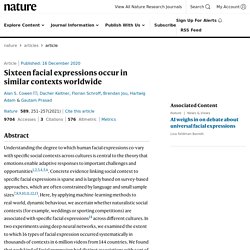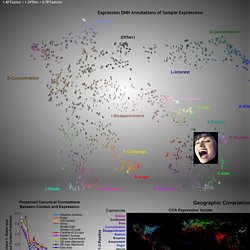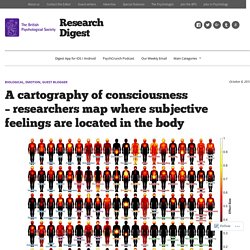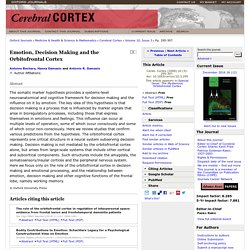

Sixteen facial expressions occur in similar contexts worldwide. 1.Cowen, A.

S. & Keltner, D. Clarifying the conceptualization, dimensionality, and structure of emotion: response to Barrett and colleagues. Trends Cogn. Sci. 22, 274–276 (2018).PubMed PubMed Central Google Scholar 2.Moors, A., Ellsworth, P. C., Scherer, K. A-Amusement B-Anger.

Tych 16 emocji okazujemy tak samo na całym świecie. Udowadnia to interaktywna mapa - National Geographic. Niezależnie od tego, czy na przyjęciu urodzinowym w Brazylii, na pogrzebie w Kenii czy na protestach w Hongkongu, wszyscy ludzie używają różnych odmian tego samego wyrazu twarzy w podobnych kontekstach społecznych – wynika z badania przeprowadzonego przez Uniwersytet Kalifornijski w Berkeley.

Nowe badanie wykazało, że ludzka ekspresja emocjonalna wyrażana za pomocą mimiki jest uniwersalna dla całej populacji. Twoja umiejętność czytania psich emocji mówi o tym, skąd pochodzisz - National Geographic. Nowe badanie szokuje naukowców. Ludzkie emocje fizycznie wpływają na rzeczywistość! - Dobre Wiadomości. Entertainment is Emotion: The Functional Architecture of the Entertainment Experience: Media Psychology: Vol 11, No 1. Current standard accounts of entertainment have regarded emotions as essential for the entertainment experience, but it has not been understood why emotions are so important for it.

Recent views of entertainment as an adaptively significant activity propose that the distal cause of entertainment activity is an unconscious need for training useful capabilities, whereas the proximal cause is enjoyment of the activity for its own sake. This theoretical paper argues emotions provide the link between distal and proximal causes of engaging in entertainment. Unpacking the cognitive architecture of emotion processes. - PsycNET. How Emotional Sensitivity Changes As We Age. Why do we become more positive as we grow older?

Why are adolescents so sensitive to negative social cues? These are a few of the questions addressed in “Emotion Sensitivity Across the Lifespan: Mapping Clinical Risk Periods to Sensitivity to Facial Emotion Intensity,” a new paper published in the Journal of Experimental Psychology: General. The paper presents findings from a groundbreaking study examining how people of all ages detect subtle changes in social cues. Artist Interview: Akaji Maro (Dairakudakan) Can we assume that it is these emotions and passions that lie at the core Akaji Maro the artist?

That is true to a large degree. For example, I think the expression on a person’s face in a jolting moment of surprise is the same any place in the world. 646. Study finds orgasm face and pain face are not the same. A cartography of consciousness – researchers map where subjective feelings are located in the body. By guest blogger Mo Costandi “How do you feel?”

Is a simple and commonly asked question that belies the complex nature of our conscious experiences. Bodily Sensations Give Rise to Conscious Feelings. New research helps to understand how illnesses and bodily states in general influence our subjective well-being.

Credit: University of Turku A Finnish research group from the University of Turku, University of Tampere and Aalto University has mapped the organisation of human conscious feelings and found them to cluster into five major categories: positive emotions, negative emotions, cognitive functions, somatic states, and illnesses. Humans constantly experience an ever-changing stream of subjective feelings that is only interrupted during sleep and deep unconsciousness. Finnish researches show how the subjective feelings map into five major categories: positive emotions, negative emotions, cognitive functions, somatic states, and illnesses. All these feelings were imbued with strong bodily sensations. – These results show that conscious feelings stem from bodily feedback.
According to the researchers, emotions vividly colour all our feelings as pleasant or unpleasant. Emotion, Decision Making and the Orbitofrontal Cortex. The somatic marker hypothesis provides a systems-level neuroanatomical and cognitive framework for decision making and the influence on it by emotion.

The key idea of this hypothesis is that decision making is a process that is influenced by marker signals that arise in bioregulatory processes, including those that express themselves in emotions and feelings. This influence can occur at multiple levels of operation, some of which occur consciously and some of which occur non-consciously. Here we review studies that confirm various predictions from the hypothesis. After 75 Years Of Research, Harvard Study Found That Happiness Comes From One Thing… PNAS 2014 Nummenmaa 646 51. Beck. The contribution of general features of body movement to the attribution of emotions. The contribution of general features of body movement to the attribution of emotions (Citations: 73) The present study was designed to assess the contribution of general features of gross body movements to the attribution of emotions.

Eighty-five adult subjects were shown ninety-six videotaped body movements, performed by three actors. Each movement was determined by seven general dimensions: trunk movement, arm movement, vertical direction, sagittal direction, force, velocity and directness. Using rating scales, the subjects judged the compatibility of each movement with each of twelve emotion categories. The results showed which movement features predicted particular ratings. Bright Side - Journal. Scientists have shown what our emotions actually look like. Our bodies experience a range of physical sensations depending on whether we feel joy, sadness, or fear.
Scientists from Finland recently discovered through precisely which parts of our body we experience a range of emotions. They represented this visually by showing the strongest emotions and sensations in yellow and red. Those areas of the body where their test subjects experienced a weak emotion were represented in a dark or light blue color. We at Bright Side found it truly fascinating to learn what our emotions and their corresponding physical sensations ’look’ like in our bodies. Daniel Goleman. Daniel Goleman (born March 7, 1946) is an author, psychologist, and science journalist. For twelve years, he wrote for The New York Times, reporting on the brain and behavioral sciences. His 1995 book, Emotional Intelligence was on The New York Times bestseller list for a year-and-a-half, and a best-seller in many countries, in print worldwide in 40 languages.